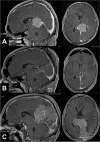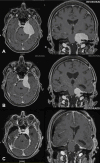Grading meningioma resections: the Simpson classification and beyond
- PMID: 38261164
- PMCID: PMC10806026
- DOI: 10.1007/s00701-024-05910-9
Grading meningioma resections: the Simpson classification and beyond
Abstract
Technological (and also methodological) advances in neurosurgery and neuroimaging have prompted a reappraisal of Simpson's grading of the extent of meningioma resections. To the authors, the published evidence supports the tenets of this classification. Meningioma is an often surgically curable dura-based disease. An extent of meningioma resection classification needs to account for a clinically meaningful variation of the risk of recurrence depending on the aggressiveness of the management of the (dural) tumor origin.Nevertheless, the 1957 Simpson classification undoubtedly suffers from many limitations. Important issues include substantial problems with the applicability of the grading paradigm in different locations. Most notably, tumor location and growth pattern often determine the eventual extent of resection, i.e., the Simpson grading does not reflect what is surgically achievable. Another very significant problem is the inherent subjectivity of relying on individual intraoperative assessments. Neuroimaging advances such as the use of somatostatin receptor PET scanning may help to overcome this central problem. Tumor malignancy and biology in general certainly influence the role of the extent of resection but may not need to be incorporated in an actual extent of resection grading scheme as long as one does not aim at developing a prognostic score. Finally, all attempts at grading meningioma resections use tumor recurrence as the endpoint. However, especially in view of radiosurgery/radiotherapy options, the clinical significance of recurrent tumor growth varies greatly between cases.In summary, while the extent of resection certainly matters in meningioma surgery, grading resections remains controversial. Given the everyday clinical relevance of this issue, a multicenter prospective register or study effort is probably warranted (including a prominent focus on advanced neuroimaging).
Keywords: Extent of resection; Meningioma; Meningioma surgery; Simpson grading.
© 2024. The Author(s).
Figures







References
-
- Ahmadi J, Hinton DR, Segall HD, Couldwell WT (1994) Surgical implications of magnetic resonance-enhanced dura. Neurosurgery 35:370–377. 10.1227/00006123-199409000-00003 - PubMed
-
- Baumgarten P, Gessler F, Schittenhelm J, Skardelly M, Tews DS, Senft C, Dunst M, Imoehl L, Plate KH, Wagner M, Steinbach JP, Seifert V, Harter PN (2016) Brain invasion in otherwise benign meningiomas does not predict tumor recurrence. Acta Neuropathol 132:479–481 - PubMed
-
- Behling F, Fodi C, Hoffmann E, Renovanz M, Skardelly M, Tabatabai G, Schittenhelm J, Honegger J, Tatagiba M (2021) The role of Simpson grading in meningiomas after integration of the updated WHO classification and adjuvant radiotherapy. Neurosurg Rev 44:2329–2336. 10.1007/s10143-020-01428-7 - PMC - PubMed
-
- Behling F, Bruneau M, Honegger J, Berhouma M, Jouanneau E, Cavallo L, Cornelius JF, Messerer M, Daniel RT, Froelich S, Mazzatenta D, Meling T, Paraskevopoulos D, Roche P-H, Schroeder HWS, Zazpe I, Voormolen E, Visocchi M, Kasper E, Schittenhelm J, Tatagiba M (2023) Differences in intraoperative sampling during meningioma surgery regarding CNS invasion - results of a survey on behalf of the EANS skull base section. Brain Spine 3:101740. 10.1016/j.bas.2023.101740 - PMC - PubMed
-
- Bernat AL, Priola SM, Elsawy A, Farrash F, Pasarikovski CR, Almeida JP, Lenck S, De Almeida J, Vescan A, Monteiro E, Zadeh GM, Gentili F (2018) Recurrence of anterior skull base meningiomas after endoscopic endonasal resection: 10 years’ experience in a series of 52 endoscopic and transcranial cases. World Neurosurg 120:e107-e113. 10.1016/j.wneu.2018.07.210 - PubMed
Publication types
MeSH terms
LinkOut - more resources
Full Text Sources

